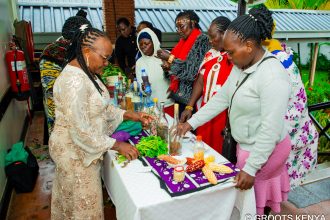By Lenah Bosibori
A new county-focused initiative is taking shape to bring safer milk to more Kenyan homes while strengthening the businesses of informal dairy vendors. Known as More Milk for Lives and Livelihoods 2 (MoreMilk 2), initiative is spearheaded by the Kenya Dairy Board (KDB) and the International Livestock Research Institute (ILRI).
The initiative has earmarked Uasin Gishu, Nakuru, and Nyandarua counties for the project’s implementation. These consultations with county leadership and stakeholders aims to co-create an approach rooted in local priorities, laying the groundwork for future expansion to other counties across Kenya.
“Despite having a strong formal sector, informal milk markets still dominate. We must find a way to work with them rather than against them. We need to rethink how we police the sector, how we empower them so they can be more compliant,” said Maritim Kimutai, KDB Director of Regulatory Services.
The aim is to professionalize Kenya’s informal dairy sector, where most Kenyans purchase their milk. It also seeks to make this sector safer, more compliant, inclusive, and economically viable for farmers, vendors, and customers. “At its heart, MoreMilk 2 supports counties in unlocking the potential of informal milk markets to improve public health, grow businesses, and uplift livelihoods,” reiterated Kimutai.
Building on the success of MoreMilk 1, a pilot program implemented in Eldoret, MoreMilk 2 demonstrated how informal milk vendors can be agents of positive change when equipped with the right support. The program approaches transformation through several key strategies.
The initiative recognizes that over 70% of milk consumed in Kenyan households is sourced informally. Instead of viewing this as a challenge, MoreMilk 2 sees a chance to reposition informal vendors as part of the solution. By creating a more appropriate compliance pathway, the initiative helps vendors become legitimate players in the food system.
“MoreMilk 2 is also deeply rooted in research. It draws on solid evidence generated by ILRI to shape practical solutions,” he added. “By bridging research, policy, and on-the-ground practices, the initiative ensures decisions are not only evidence-based but also responsive to the real-world dynamics of the informal dairy economy.
The county visits were designed as a listening tour rather than a formal launch. During these visits, the MoreMilk 2 team engaged with County Executive Committee Members (CECMs), and directors of agriculture, livestock, public health, cooperatives, and regulatory teams. The purpose was to understand ongoing efforts and ensure the initiative complements county priorities and strategies.
“With MoreMilk 1 in Eldoret, we saw vendors grow their businesses and children drinking more milk. MoreMilk 2 builds on that success with a system-wide focus from farmer to vendor,” noted Abraham Kiptanui, Uasin Gishu County Director of Livestock Production.
The counties are key to shifting the current enforcement-heavy model into one that emphasizes empowerment. Through training, coaching, and incentives, MoreMilk 2 encourages informal vendors to adopt best practices, emphasizing that safe milk is good not just for consumers but also for business.
“Nakuru does not condemn informal vendors; instead, it tries to organize and train them. That’s why the MoreMilk 2 initiative resonates well with us, as it seeks to invest in and build the capacity of informal sector vendors rather than sidelining them,” said Virginia Ngunjiri, Director of Livestock Production, Nakuru County.
The initiative also extends beyond milk safety. It offers training in business skills, promotes gender inclusion, and weaves climate resilience into daily practices. By working within the realities of informality, it gives vendors the tools and motivation to improve milk safety, grow their income, and expand their operations.
“MoreMilk 2 is not just about milk. It is about dignity. It is about equity. And it is about building a system where everyone – vendors, farmers, consumers, government – wins,” said Silvia Alonso, Principal Scientist, ILRI.
For dairy-producing counties like Nyandarua, the initiative also opens the door to increased local consumption, especially among children, while generating new economic opportunities.
“Nyandarua is a dairy-producing county, but not yet a dairy-consuming one. By strengthening the local dairy markets, we can increase access to milk for our children while opening new opportunities for our farmers and vendors,” said Francis Miring’u, County Executive Committee Member for Health Services.
These first county visits have laid a strong foundation for county-driven implementation of MoreMilk 2. The energy and insights from Uasin Gishu, Nakuru, and Nyandarua reflect a shared commitment to transforming Kenya’s dairy sector from the ground up.
Next steps include deeper engagement with county governments and local partners, rolling out a comprehensive training and certification program for vendors, establishing inclusive and safe informal milk market hubs, and strengthening policy and investment frameworks to support long-term success.
The ambition is clear: deliver more safe milk to more households while unlocking more value for informal vendors, farmers, and communities.




